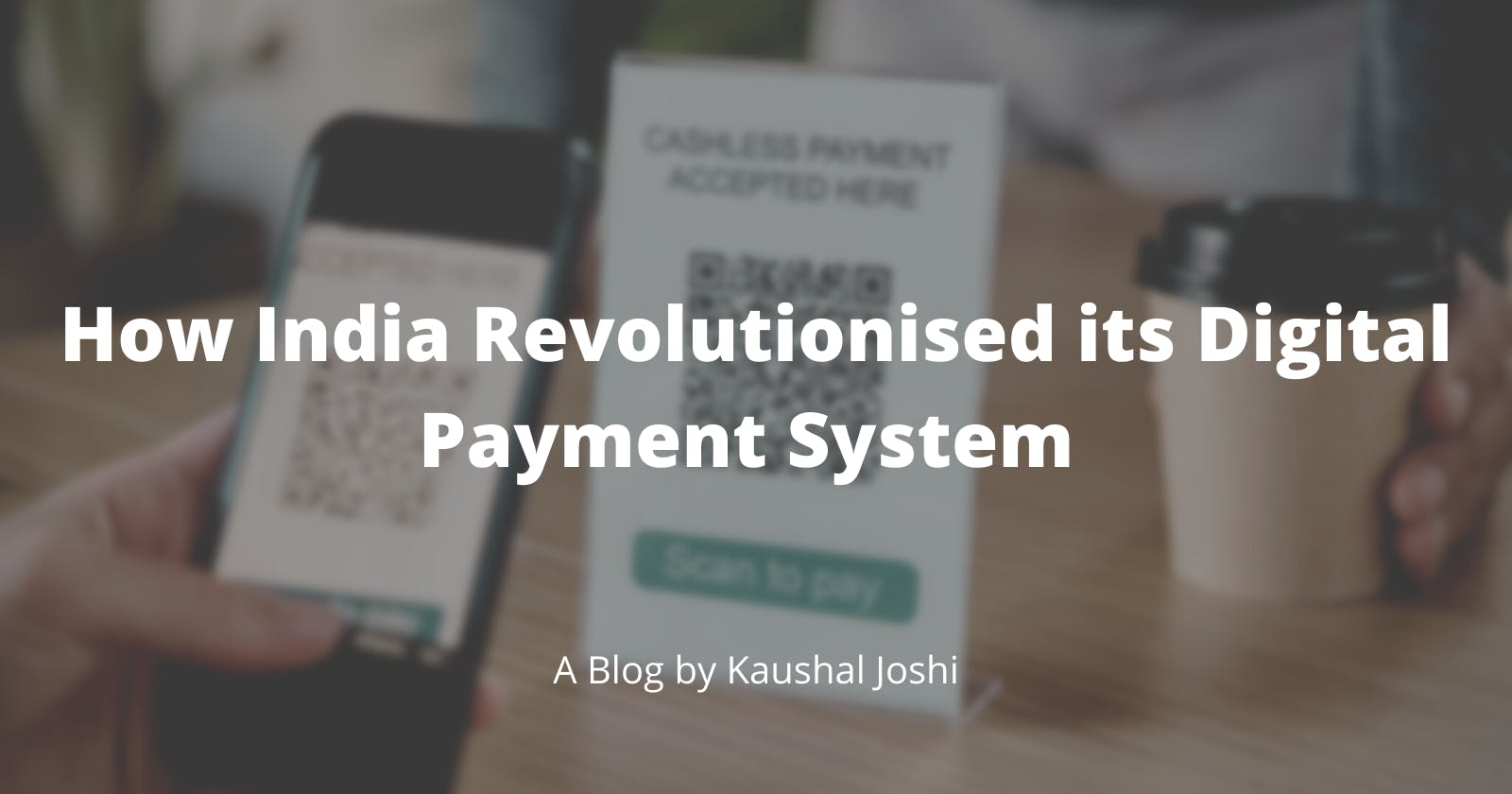As most of the world is still using cheques or some kind of card to transact money, India has developed a system that allows the transaction of money in no time without any transactional fees.
Unified Payments Interface or UPI is an instant real time payment system that facilitates inter-bank transactions. As of January 2022, it is India’s widely accepted mode for financial peer-to-peer as well as peer-to-merchant transactions.
It became so successful that in November 2019 Google recommended to US Federal Reserve Board to develop a UPI-like real time payment solution for the USA.
In just five years, UPI has revolutionized the way Indians used digital payment systems. UPI has surpassed global giants like Mastercard, Visa and has also outpaced traditional methods like E-wallets and net banking.
India Before UPI
In a survey conducted in March 2011, the Reserve Bank of India(RBI) found out that on average every citizen is doing only six non cash transactions in a year. However, around 10 million retailers accept debit or credit cards as a method of transaction.
On further investigation, RBI concluded possible reasons for the failure of card based payment system in India.
- Digital literacy: At that time, a small fraction of the population had smartphones and the internet. The number of people who could afford cards or smartphones on daily basis was negligible.
- Transactional fees: Merchant had to pay a 2% charge for every transaction to the card company. This was not possible for many small or medium scaled businesses.
- Complexity: The process of sending or receiving money was lengthy and expensive. Merchants had to have a machine to accept cards. People had to enter detailed information of the receiver in order to send the money.
To tackle this, in 2012, RBI stated a vision statement for the next four years. developing an authorized payment system which would be:
- Safe
- Efficient
- Accessible
- Inclusive.
- Interoperable
This vision was a part of a green initiative system, one of the objectives of which was to reduce the use of paper. This led to the birth of the United Payments Interface or UPI.
United Payments Interface
UPI was launched for public use in April 2016. UPI was developed to remove all the friction in digital payments and create an easy, secured way to transact money. It didn’t catch much of the public attention until one day.
On 8th November 2016; Prime Minister Narendra Modi demonetized the nation’s 86% of currency in circulation. At that time more than 90% of the nation’s transactions were conducted in cash, more than 85% of workers were getting paid in cash, and about half the population didn’t even have a bank account! Demonetization forced people to consider digital payments for transacting money.
Before UPI, customers had to submit a cheque or use bank portals if they wanted to transfer money. This was not only time consuming but also expensive to use on a regular basis. With UPI, it was possible for third party companies to debit or credit money directly from a customer’s bank account.
Architecture of UPI
National Payments Corporation of India (NPCI) developed a secure backend system that makes it possible for third parties to facilitate transactions on behalf of the customer.
UPI debarred the need of entering bank or card details before every transaction. Every user has a unique Virtual Payment Address(VPA) which is a combination of a username and a customers bank account.
If Alice wants to send money to Bob, she only needs to know Bob’s VPA (or sometimes contact number only) for the transaction to become successful. This changed the way Indians think of internet banking.
What Makes UPI unique?
Real-Time Payment System
Traditional methods such as cheque, NEFT, RTGS take a couple of business days to transfer money. UPI transactions are completed within a few minutes seconds. Moreover, the system is available 24*7 and you can use it from any part of the country. All it needs is a mobile phone and a stable internet connection.
Third Party Companies
UPI is not limited to any central authority or neither can be considered as a product owned by the government. It’s a service made available to everyone via NPCI. Anyone can work with NPCI to develop a UPI backed payment service. PayTM, Amazon, Google, PhonePe to name a few.
A customer is not forced to use a particular system and is free to use the platform that they want. This is one of the main reasons behind the major success and social acceptance of UPI. Companies always thrive to provide the best features to gain more customers which creates a competitive market for third party payment applications.
Interoperability
Interoperability was included in the mission statement of UPI. If the sender is unaware of receiver’s VPA, they can also use their mobile number, AADHAR number or even good ol’ IFSC/Bank Account Number. UPI allows seamless transactions between two users regardless of their bank account, payment app or location.
Interoperability gives more freedom to the customer than third party app. Customers are not tied to sending or receiving money from one app only.
Push-Pull
When most of the other alternatives have an option to send money, UPI allows merchants/customers to ask for money from another user.
Security
- Personal Information: VPA makes it possible to transfer money without disclosing your name, contact number, AADHAR number, bank details, etc.
- 1-click 2-Factor authentication: This adds security extra security layer to the app used by users. Before sending money, user needs to enter a PIN or verify Biometrics to confirm transactions.
How UPI beat Visa and MasterCard
UPI took over card payments in April 2021. According to RBI, 15.8crores transactions were conducted in April 2021 via credit card whereas UPI handled 119.2 crore UPI based on P2M transactions alone valued at 81,836 crores INR.
Tier 3 Cities
Visa and MasterCard have dominated the global financial sector for a long time. Somehow it never got into mainstream Indian markets. I talked to many folks of my parents’ age. Most of them had a debit or credit card but they hardly ever used it. Using cards for payments was expensive, tedious and sometimes impossible. None of the two competitors could ever reach tier two or three Indian cities.
UPI did exactly that. The simplicity of UPI transactions made it possible for people who were not familiar with technology to adapt and use it. Third party companies have established themselves in many fields and domains that used VISA or Mastercard for transactions. Customers get many rewards and cash back because of the competition between third parties.
Zero MDR
UPI announced Zero Merchant Discount Rate (Zero MDR) in peer to merchant (P2M) transactions that enables UPI transactions to happen without any transactional fees. Unlike card payments, using UPI became beneficial for both customers and merchants.
Pandemic and Lockdown
The second most important factor after demonetization that helped UPI to become accepted is nationwide lockdown in March 2021. To follow regulations of social distancing and lockdown, people were again forced to use cashless options. And this time, they choose UPI over anything else.
In March 2021, UPI crossed a total of 2.73billion transactions valued at 5.04 lakh crore Indian rupees. Then In June 2021, a total of 2.8billion transactions were conducted with a total value of 5,47,373cores Indian rupees. It was the same time when UPI took the crown of digital payments from card based transactions.
For end users, regardless of them being a customer or a merchant, using UPI based payment system was infinitely better than cards. It saved their money, time and brain cells by a lot of margins.
What Next?
Improvements
Offline Digital Payments*
At the start of this new year, RBI announced a framework for carrying out offline digital payments in India. Offline digital transactions would not require internet or telecom connectivity. Users would be able to transact money via mediums like cards, wallets or mobile phones. Many rural and remote areas in India have weak connectivity. Having an offline mode of digital transaction would enable many villagers to use digital payments.
Expanding to Global Markets
In August 2020, NPCI launched ‘NPCI International Payments Limited’ or NIPL, which is an NPCI owned subsidiary for expanding UPI and RuPay in international financial markets.
In an interview, Ritesh Shukla, CEO of NIPL said:
“We are aiming to expand RuPay and UPI acceptance across world destinations, where Indians travel for holidays, study or profession or even stay. We are in talks with global agencies through which we are looking to introduce RuPay and UPI to the world.”
He didn’t disclose names of agencies or destinations by some likely destinations might be UAE, Saudi Arabia and some European and North American countries.
Helping other countries
Many countries have shown interest in developing a UPI backed payment model for themselves.
Recently RBI announced that it is going to sign a pact with the Monetary Authority of Singapore. UPI will be linked with PayNow. July 2022. Merchants from Singapore have already started to accept BHIM as a mode of payment.
Bhutan is also adapting Indian UPI and is the first country to Indian UPI standards for its QR codes. Royal Monetary Authority of Bhutan partnered with NPCI to launch this.
NIPL is trying to implement a real time payment system in Myanmar. They have submitted a proposal to the Central Bank of Myanmar to introduce a real-time payment system in the country.
Network Operational, a company that enables digital commerce in Middle East Africa has signed a memo of understanding with NIPL. We can see UPI based service in UAE very soon.
SWIFT
SWIFT is the biggest International Payment Settlement System. Many banks and financial institutions use SWIFT for transferring money internationally. If UPI keeps growing with such momentum, it would create a tough competition for SWIFT.
But I believe the road won’t be easy. SWIFT conducts around 5 trillion dollars of transactions per day, whereas UPI conducts 30 million transactions a day. Also, SWIFT has more than 11,000 members across the world. UPI on the other hand has around 220 banks.
Conclusion
From not making cashless transactions to using cashless payment even for a payment worth of a rupee, India has come so long in the past four years. UPI has a lion’s share in making this possible. Revolution is not easy, even if it is a digital one. Especially in a country like India, where using smartphones and the internet was considered a luxury a few years back. The planning, implementation and execution behind the Indian digital revolution are really interesting and could be a whole separate topic of a case study.
If you find this article helpful, or you think something can be improved, do let me know. I am most active on Twitter, LinkedIn and Showwcase!
Happy Going Cashless 📱

Kaushal Joshi is a versatile author with expertise in web development and technical writing. With a passion for both coding and effective communication, Kaushal has forged a dynamic career at the intersection of technology and content creation. His proficiency in web development is complemented by a talent for articulating complex technical concepts in clear and accessible language. Through his writing, Kaushal not only contributes to the evolving field of web development but also empowers readers with the knowledge to navigate the digital landscape. His commitment to bridging the gap between technology and understanding makes Kaushal Joshi a respected figure in both the web development and technical writing communities.

Leave a Reply